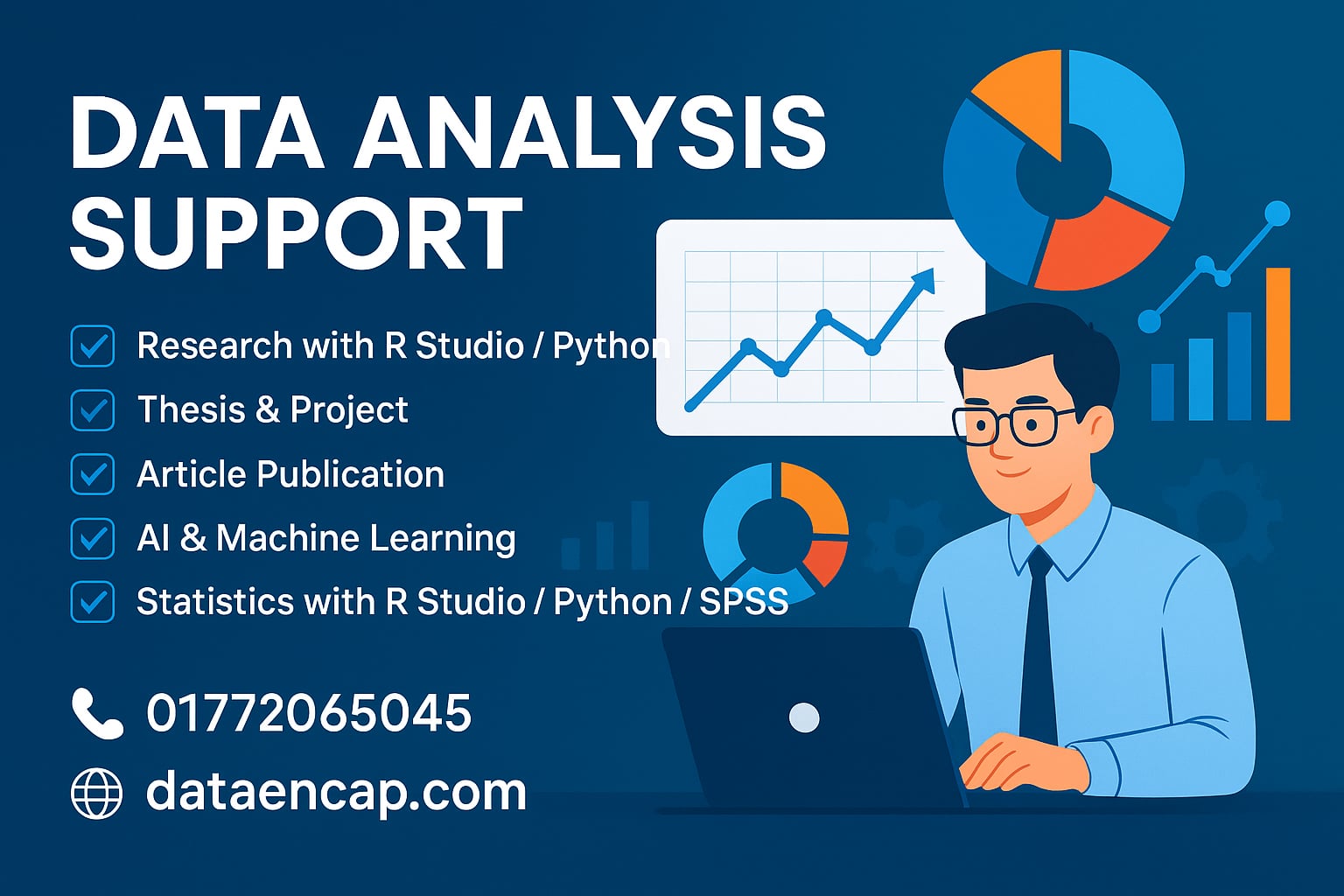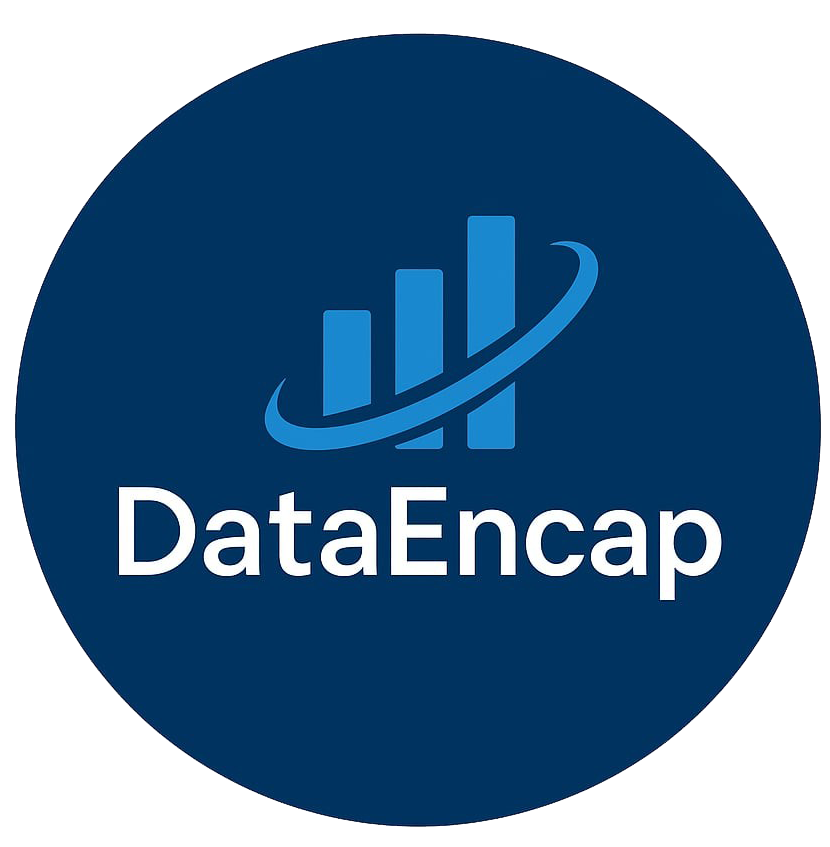Our support for:

Introduction
- Introduction
- Installing R, RStudio & key packages (tidyverse, ggplot2, readr, dplyr, tidyr)
- Basic R data types, variables, and workspace management
Data Import, Cleaning & Preparation
- Reading CSV, Excel, SPSS files in R
- Handling missing values, outliers, and duplicates
- Data transformations: factor, date, numeric conversions
- Basic feature selection and filtering
Descriptive Statistics
- Measures of central tendency (mean, median, mode)
- Dispersion: standard deviation, variance, IQR, range
- Distribution analysis: skewness, kurtosis
- Implementing summary (summary()), mean(), sd(), quantile() functions
Visualizing Single Variables
- 1. Numerical Data
- Histograms, density plots
- Boxplots and violin plots (with ggplot2)
- 2. Categorical Data
- Bar charts, pie charts
- Proportional stacked bar charts
- 3. Customizing visual aesthetics: colors, themes, labels
Bivariate & Grouped Analysis
- 1. Visualizing relationships: scatter plots, line charts
- 2. Comparative plots: side-by-side boxplot, violin plot by groups
- 3. Categorical charts: grouped & stacked bar charts
- 4. Heatmaps of cross-tabulations
- 5. Regression Analysis
- 6. Logistics Regression analysis
Case Study – Health Dataset
- 1. Explore a real-world dataset
- 2. Clean, inspect, transform data
- 3. Compute and visualize descriptive stats per group
- 4. Reporting: interpreting results for
Summary Reports & Reproducibility
- 1. Introduction to Markdown for automated reporting
- 2. Creating dynamic HTML or PDF reports
- 3. Embedding plots, tables, and narrative
- 4. Exporting clean datasets for further analysis
Interactive Dashboard and web application
- 1. Intro to Shiny for interactive visualization
- 2. Build a UI: filters for variable and grouping choices
- 3. Deploy live plots (violin, summary tables) from the case study
- 4. Package your app for sharing or hosting
Machine Learning
LR Logistic Regression
DT Decision Tree
RF Random Forest
KNN K-Nearest Neighbours
SVM Support Vector Machine
NB Naïve Bayes
Deep Learning with R Studio
Data analysis using deep learning techniques in R has revolutionized how businesses and researchers extract insights from complex datasets. Deep learning, a subset of machine learning inspired by the human brain’s neural networks, allows computers to learn from large amounts of data to make decisions and predictions.
In R, a powerful statistical programming language, deep learning frameworks like TensorFlow and Keras are widely used for tasks such as image and text analysis, natural language processing, and predictive analytics. These frameworks enable data scientists to build and train sophisticated neural networks efficiently.
Key applications of deep learning in R include:
Image Recognition: Identifying objects, faces, and patterns in images.
Natural Language Processing (NLP): Analyzing and generating human language.
Predictive Analytics: Forecasting trends and making data-driven decisions.
Anomaly Detection: Identifying unusual patterns or outliers in data.
By harnessing deep learning in R, businesses gain a competitive edge through more accurate predictions, improved customer insights, and enhanced automation of complex tasks. Whether you’re analyzing customer behavior, optimizing business processes, or conducting cutting-edge research, deep learning in R offers powerful tools to unlock the potential of your data.
Ensemble Learning with R Studio
1.Bagging
Adabag
- Boosting
GBM Gradient Boosting Machine
XGBoost Extreme Gradient Boosting
LGBM LightGBM
CatBoost Optimized for categorical variables
- Stacking
Time series analysis and Forecasting (ARIMA, SARIMA, ARDL) with R
Time series analysis is essential for understanding patterns in data collected over time and making accurate forecasts. In R, powerful statistical techniques such as ARIMA, SARIMA, and ARDL are widely used for time-based data modeling and forecasting across a variety of industries.
1. ARIMA (AutoRegressive Integrated Moving Average)
ARIMA is a foundational time series model that captures autocorrelations in stationary data. It’s ideal for short-term forecasting and helps identify trends and cycles by combining autoregression, differencing, and moving averages.
2. SARIMA (Seasonal ARIMA)
SARIMA extends ARIMA by adding seasonal components, making it perfect for datasets with repeating seasonal patterns—such as monthly sales, climate data, or visitor traffic. It effectively models both non-seasonal and seasonal behaviors.
3. ARDL (Autoregressive Distributed Lag)
ARDL models are ideal when dealing with mixed stationary and non-stationary time series data. It’s especially useful for analyzing long-run relationships and short-run dynamics between multiple variables—frequently applied in economics and policy research.
Key Applications of Time Series Forecasting in R:
Financial market trend prediction
Sales and demand forecasting
Weather and climate modeling
Economic indicator analysis
Inventory and resource planning
Using R’s robust time series packages like forecast, tseries, urca, and dynlm, analysts can perform accurate forecasting, build dynamic regression models, and generate reliable insights to support strategic decisions.
Business Analytics
- Introduction to Business Analytics
- Data Management and Data Manipulation
- Exploratory Data Analysis (EDA)
- Descriptive Analytics
- Predictive Analytics
- Prescriptive Analytics
- Tools for Business Analytics
- Applications of Business Analytics
- Ethics and Data Privacy
- Capstone Project / Case Studies
Cluster Analysis with R
Cluster Analysis and Factor Analysis
Hierarchical Clustering
K-Means clustering
C-Means clustering
Density-Based Clustering (DBSCAN)
PCA -Principal Component Analysis

Mohammed Motaher Hossain
BSc Hons, M, Sc. MS (Sweden), PhD Researcher (Portugal), Data Analyst & Statistician
